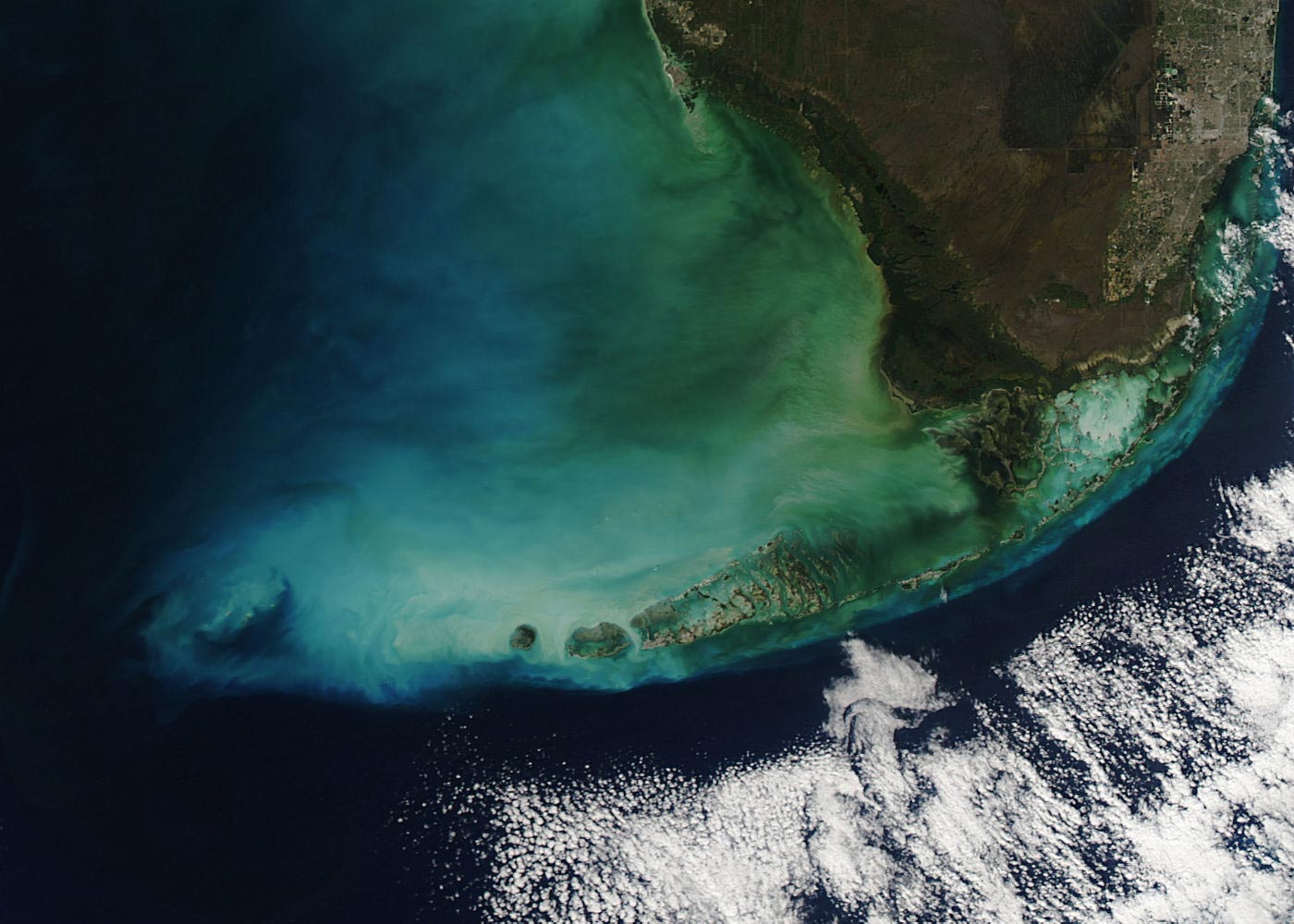Novel 3D-CHESS could help researchers develop autonomous sensor webs for Earth observation

An image from NASA’s MODIS instrument depicting an algal bloom (green) in the Florida Keys. With 3D-CHESS, researchers would be able to study algal blooms and other fast-changing events more effectively. (Image Credit: NASA).
3/26/24 – Each day, sensors scattered across Earth’s surface, dispersed throughout Earth’s atmosphere, and situated within Earth’s orbit produce torrents of scientific data, supplying researchers with more information about our world than humans have ever had before.
But quick as they are to communicate their observations with scientists, these sensors rarely communicate with one another. Each individual instrument operates in its own silo, making it difficult to orchestrate campaigns that include sensors from multiple domains.
“When it comes to Earth observation satellites and missions, the architectures are still very simple,” said Daniel Selva, an Associate Professor of Aerospace Engineering at the University of Texas, A&M. “There’s not a whole lot of onboard data processing or decision making or coordination amongst satellites in a constellation.”
Selva and a team of researchers are working with NASA’s Earth Science Technology Office to change that. Their project, “Decentralized, Distributed, Dynamic, and Context Aware Heterogenous Sensor Systems” (3D-CHESS) would allow sensors to coordinate with each other more effectively and operate with greater autonomy, uniting disparate instruments within a single, dynamic sensor web.
“The idea of a sensor web is basically to turn that static, silo-based architecture into something that looks a lot more like a dynamic network of sensors,” said Selva.
This dynamic network would make it easier to observe rapidly-changing features of Earth’s environment, such as harmful algal blooms and severe weather.
Sensor webs – collections of heterogenous sensors focused on the same task – have been around since the late 1990s, but autonomous sensor webs, like 3D-CHESS, are new.
Rather than using a human operator to organize sensor networks, 3D-CHESS would equip sensors with the intelligence they need to organize themselves with minimal human guidance. Each sensor would understand not only its own capabilities, but the capabilities of other sensors within a network.
This context-aware autonomy would make it possible, for example, for an airborne sensor to detect an event, request additional observations from space-based sensors, and then work with the space-based sensors to determine which instrument is best suited to study the event in greater detail.
In addition, rather than having a central node organizing the entire network, 3D-CHESS would use decentralized task algorithms to allow sensor webs to form and dissolve according to the observational needs of the moment.
“The idea is that sensors bid for a task based on how well they think they can perform the task and how much it is going to ‘cost’ them – in terms of energy, for example, do it. They communicate with one another to exchange these bids and whoever has the highest bid, performs the task,” said Selva.
This means that sensors maintained by different companies and government agencies could collaborate temporarily before returning to their primary missions.
“You’re really trying to get to the point where you don’t rely on the human operator to say, ‘react to an event of interest,'” explained Selva. “You don’t have to rely on human operators to decide who does what, which is what we do today.”
Instead, Selva said, instruments can use a shared reference to organize an optimal observation network on their own. This shared reference, the knowledge graph, is a key technology innovation.
“You can think of it as a database, but instead of looking like a spreadsheet or something like that, it looks like a big graph,” said Selva. The nodes and edges on the graph, he explained, are “all about what types of sensor can measure what things, and which satellites carry which types of sensors.”
Another key technology innovation will be the inference algorithms sensors use to query the knowledge graph. These algorithms help sensors answer deterministic, yes-or-no questions, as well as probabilistic, ‘how likely is this even to occur’ questions.
“You can ask questions to the knowledge graph, ‘Can I perform this task’ or ‘Is thermal infrared radiance related to temperature,’ right? You can query the knowledge graph, and get answers with probabilities,” said Selva.
3D-CHESS is a proof-of-concept project to determine if this approach is viable. To do this, Selva and his team developed a simulation that they’ll use to prototype an effective knowledge graph and a collection of task allocation algorithms.
Ultimately, their goal is to produce an accessible software tool that scientists from numerous Earth science disciplines can use to achieve ambitious research goals.
“By the end of this project, we are going to release an open source tool that is meant to be quite flexible, something that other researchers can use to try to figure out if an autonomous sensor web is a feasible and appealing approach for a given application,” said Selva.
NASA’s Advanced Information Systems Technology (AIST) program, part of NASA’s Earth Science Technology Office (ESTO), funds Selva’s project. The research team includes members from NASA’s Jet Propulsion Laboratory; NASA’s Ames Research Center; Texas A&M University; and the University of California, Los Angeles.
Gage Taylor, NASA Earth Science Technology Office